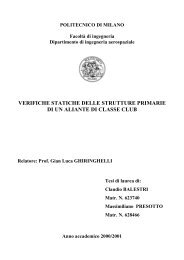You also want an ePaper? Increase the reach of your titles
YUMPU automatically turns print PDFs into web optimized ePapers that Google loves.
Meccanica<br />
del<br />
volo spaziale
Space system phases<br />
Sistemispaziali+<br />
Meccanica Volo Spaziale<br />
Design and development<br />
Technology development<br />
Component procurement<br />
Manufacturing<br />
Assembly & Integration<br />
Verification & test<br />
Meccanica Volo Spaziale<br />
Launch<br />
Meccanica Volo Spaziale<br />
Operations<br />
Harness<br />
Thermal control<br />
Electrical<br />
Telecomms<br />
power<br />
Data handling<br />
Payload<br />
AOCS<br />
Structure<br />
Propulsion<br />
Mechanisms
Design Process<br />
Mission<br />
Requirements &<br />
Constraints<br />
Software<br />
Objectives<br />
Environment<br />
Lifetime<br />
Payload<br />
Reliability<br />
Schedule<br />
Technology<br />
Budget<br />
Attitude<br />
determination<br />
& control<br />
Mission<br />
analysis<br />
Thermal<br />
control<br />
Instruments<br />
Electrical<br />
power<br />
Dry<br />
mass<br />
Data<br />
handling<br />
Telemetry<br />
tracking &<br />
command<br />
Operations<br />
& ground<br />
systems<br />
Study<br />
Results<br />
S/C Design<br />
S/C Configuration<br />
Launcher<br />
Risk<br />
Cost<br />
Simulation<br />
Study Requirements<br />
Products<br />
Study Level<br />
Planning<br />
Resources<br />
Propellant<br />
mass<br />
Propulsion<br />
Structure<br />
Adapter<br />
Wet<br />
mass<br />
Launch<br />
mass<br />
Programmatics<br />
Options<br />
Conceptual model<br />
of mission &<br />
spacecraft<br />
design process
Trajectory classes<br />
Mission Analysis Trajectory and trajectory control design<br />
Meteosat<br />
Ulysses<br />
Olympus<br />
ERS<br />
Hipparcos<br />
Soho<br />
Huygens (Cassini)<br />
Spacelab<br />
Ariane 4 Ariane 5<br />
Envisat<br />
ECS<br />
International<br />
Space Station<br />
ISO<br />
Artemis<br />
Giotto
Mission phases: Earth Satellite Example<br />
Launch –Low Earth Orbit Phase (LEOP) -Transfer – Commissioning –<br />
Operations – De-commissioning - End of Life<br />
AGILE (04/07)<br />
Astro-rivelatore Gamma<br />
a Immagini Leggero
Mission phases:<br />
interplanetary transfer trajectory example<br />
Ulysses (10/90)<br />
Plane inclination<br />
variation:Gravity assist<br />
maneuver: 80.2 deg<br />
Mass at launch: 370 kg<br />
Payload mass: 55 kg<br />
Fuel mass: 33 kg<br />
Power: 285 W
Mission phases:<br />
interplanetary transfer trajectory example<br />
Cassini-Huygens (10/97)<br />
Gravity Assist : Venus-Venus-<br />
Earth-Jupiter<br />
Launch Mass: 2523 kg<br />
Fuel Mass: 1027 kg<br />
Power: 640 W
Mission phases:<br />
interplanetary transfer trajectory<br />
example<br />
Messenger (08/04)<br />
Mass: 1100 kg<br />
Fuel mass 592 kg<br />
Payload mass 50 kg<br />
Power: 450 W
Mission phases:<br />
interplanetary transfer trajectory example<br />
Messenger 1° GA Earth<br />
2005<br />
Messenger 2° GA Venus<br />
2006<br />
Messenger MOI<br />
2011
Trajectory design<br />
Rosetta (03/04)<br />
Launch Mass: 3000 kg<br />
Fuel mass 1800 kg<br />
Power: 850 W
Programma del Corso<br />
Sistemi di riferimento e misura del tempo<br />
Sistemi di riferimento: Eliocentrico-Eclittico; Geocentrico-Equatoriale; Topocentrico-<br />
Orizzontale. Fenomeno della precessione degli equinozi. Misura del tempo: tempo solare e<br />
tempo siderale. La data Giuliana. (Navigazione interplanetaria)
Programma del Corso<br />
Meccanica Celeste<br />
Il problema degli n corpi. Potenziale gravitazionale. Il problema dei due corpi. Richiami di proprietà<br />
geometriche delle coniche. Legami sussistenti tra le costanti del moto e la geometria dell'orbita. Analisi<br />
energetica orbitale. Calcolo del periodo orbitale e leggi di Keplero.<br />
Orbite kepleriane<br />
Definizione dei sei elementi orbitali classici. Trasformazioni di coordinate tra i vari sistemi di riferimento.<br />
Calcolo dell'orbita dati gli stati iniziali. Tempo di volo: Equazione di Keplero. Metodi numerici per il<br />
calcolo dell'anomalia eccentrica.<br />
Facoltativo: Problema di Lambert e sua soluzione nel caso di orbita ellittica. Traiettorie interplanetarie.<br />
Sfere di influenza. Metodo delle coniche raccordate.
Programma del Corso<br />
Manovre orbitali<br />
Manovre impulsive ad un impulso e a due impulsi (trasferimenti alla Hohmann e manovre biellittiche).<br />
Manovre impulsive a tre impulsi: coplanari e con cambiamento di piano orbitale. Trasferimento orbitale<br />
tra orbite ellittiche. Trasferimenti orbitali con impulso fissato. Finestra di lancio. Trasferimenti con<br />
spinte basse. Perdite di gravità. Manovre di rifasamento.<br />
Documento Acrobat
Programma del Corso<br />
Progetto e dinamica dei lanciatori<br />
Dinamica impulsiva. Dinamica di un monostadio: lancio sulla verticale; lancio balistico;<br />
Ottimizzazione di un pluristadio.<br />
Facoltativo: dinamica bidimensionale di lancio
Programma del corso<br />
Perturbazioni orbitali<br />
Orbite particolari ottenute attraverso l’effetto perturbativo: sunsincrone, Molnya<br />
Moto di assetto di un satellite (facoltativo)<br />
Richiami di meccanica dei corpi rigidi. Terne di riferimento. Angoli di Eulero.<br />
Equazioni di Eulero. Stabilità delle rotazioni attorno agli assi principali di inerzia.<br />
Dinamica di satelliti a tre gradi di libertà attorno al baricentro. Calcolo del gradiente di<br />
gravità. Dinamica dei satelliti stabilizzati a gradiente di gravità.
Sistemi di riferimento e misura del tempo<br />
V.M.Blanco “Basic physic of the solar system”, Addison Wesley Ed.<br />
Dispense del Corso<br />
.Progetto e dinamica dei lanciatori<br />
K.J.Ball, G.F.Osborne, “Space Vehicle Dynamics”, Oxford Press<br />
Dispense del Corso<br />
Problemi di Meccanica Celeste<br />
M.H.Kaplan, Modern Spacecraft Dynamics and Control”, J.Wiley & Sons<br />
R.Bate,D.Mueller,J.White,”Fundamentals of astrodynamics”, Dover Pubbs, NY<br />
G.Mengali,”Meccanica del volo spaziale”, Ed.PLUS<br />
Orbite kepleriane<br />
H.D.Curtis, Orbital Mechanics for Engineering Students<br />
V.A.Chobotov, “Orbital Mechanics”, AIA education series<br />
G.Mengali,”Meccanica del volo spaziale”, Ed.PLUS<br />
M.H.Kaplan, Modern Spacecraft Dynamics and Control”, J.Wiley & Sons<br />
Manovre orbitali<br />
H.D.Curtis, Orbital Mechanics for Engineering Students<br />
G.Mengali,”Meccanica del volo spaziale”, Ed.PLUS<br />
C.Brown,”Space Mission Design”,AIAA Education series<br />
Perturbazioni orbitali<br />
M.H.Kaplan, Modern Spacecraft Dynamics and Control”, J.Wiley & Sons<br />
C.Brown,”Space Mission Design”,AIAA Education series<br />
Moto di assetto di un satellite<br />
M.H.Kaplan, Modern Spacecraft Dynamics and Control”, J.Wiley & Sons<br />
W.Viesel, “Spaceflight Dynamics”, Mc Graw-Hill<br />
References
Exam rules<br />
Modalità di valutazione<br />
Tipologia delle prove<br />
Le prove necessarie ai fini della valutazione del corso consistono in:<br />
a) 3 compitini scritti ciascuno relativo ad un’area tematica affrontata nel corso e composto da alcuni esercizi numerici e<br />
domande teoriche<br />
b) interrogazione orale sul programma svolto<br />
I compiti scritti vengono svolti durante il corso, al termine del periodo di lezione/esercitazione inerenti all’argomento<br />
trattato; indicativamente:<br />
1. Prima metà doi Novembre: trasformazioni di coordinate<br />
2. Fine Dicembre: Meccanica Orbitale<br />
3. Fine Gennaio: lanciatori<br />
La valutazione dei compiti scritti è la seguente:<br />
Valutazione<br />
gravemente insufficiente<br />
insufficiente<br />
Sufficiente/discreto/buono/ottimo<br />
Voto<br />
E*<br />
E<br />
D/C/B/A<br />
Esito<br />
impedisce la partecipazione all’orale; richiede lo<br />
svolgimento in aula di uno scritto<br />
Richiede lo svolgimento a casa del tema del compito<br />
Consente la partecipazione all’orale il cui voto di<br />
partenza è definito dalla media dei voti acquisiti nei<br />
compiti<br />
• L’insufficienza grave in 3 scritti preclude l’ammissione all’orale e implica la re-iscrizione e frequenza del corso<br />
• L’insufficienza grave in 2 scritti richiede lo svolgimento in aula di uno scritto su tutto il programma svolto<br />
• L’insufficienza grave in 1 scritto implica lo svolgimento in aula di uno scritto relativo alle tematiche insufficienti<br />
Regole dell’esame<br />
Sono previsti appelli d’esame a Febbraio, Giugno/Luglio Settembre per sostenere la prova orale.
Reference systems
Reference systems<br />
Goal: to describe the state vector of an object in space<br />
Coordinate system: cartesian/spherical<br />
Coordinate<br />
Name<br />
Celestial<br />
Fixed with<br />
or respect<br />
to<br />
inertial space<br />
Centre<br />
Earth (GCI<br />
Geocentric<br />
Inertial) or<br />
body<br />
Z-axis<br />
X-axis or<br />
Ref.Point<br />
Application<br />
Celestial Pole Vernal Equinox orbit analysis, astronomy<br />
Ecliptic inertial space Sun/Earth Ecliptic Pole Vernal Equinox<br />
solar system orbits, planet<br />
ephemeris<br />
Planet-fixed Planet Planet Planet Pole<br />
Greenwich or 0<br />
meridian<br />
apparent satellite motion<br />
Perifocal Orbit Planet<br />
Angular<br />
momentum<br />
Eccentricity<br />
vector<br />
Orbit analysis<br />
Spacecraft<br />
fixed<br />
RPY, RθB,<br />
NTB<br />
Spacecraft<br />
s/c c.m.<br />
Dependent<br />
on the<br />
design<br />
Body<br />
(spacecraft<br />
or other)<br />
Spacecraft axis<br />
toward nadir<br />
Yaw in the nadir<br />
or R in the radial<br />
direction<br />
spacecraft axis in<br />
the direction of<br />
velocity<br />
perpendicular to<br />
nadir toward<br />
velocity<br />
position and orientation of<br />
instruments<br />
attitude manoeuvres, planet<br />
observation and encounter<br />
Main plane + reference axis to be defined<br />
Orbital<br />
Mechanics
Revolution: angular motion of the c.m around the Sun<br />
Reference systems: planets motion<br />
Rotation: angular motion of the planet around its own axis<br />
Revolution axis<br />
equator<br />
23°27’<br />
Rotation axis<br />
Revolution axis<br />
equator<br />
Earth Orbit<br />
plane<br />
Venus<br />
Orbit plane<br />
Rotation axis<br />
177°
Rotation motion effects<br />
• daylight and night experienced<br />
• apparent daily motion of the Sun and night motion of the stars in the<br />
sky<br />
• polar bulginess<br />
• different escape velocity with latitude<br />
• deviations of objects moving along meridians because of the Coriolis<br />
apparent acceleration, depending on the latitude:<br />
– null at poles, maximum at equator (N S displacement = boreal<br />
hemisphere West deviation)
Revolution motion effects<br />
• Seasons existence (inclined rotational axis)<br />
• Different height of the Sun above the horizon along the year<br />
• Different rising and sunset points on the horizon along the year (at<br />
East-West at Equinoxes; toward North in summer and South in winter<br />
for a boreal observer)<br />
• Apparent rotation of the sky<br />
• Apparent annual motion of the Sun (Zodiac band rotation)
planets motion: relevant events<br />
Two particular illumination conditions can be identified:<br />
Equinox: Sun rays are perpendicular to the Earth (planet) equator; daylight<br />
and night duration is equal all over the planet<br />
Solstice: Sun rays are oblique to the surface, different latitudes experience<br />
different daylight/night duration
planets motion: relevant events<br />
Solstice line<br />
Equinoxes line
planets motion: relevant events\points<br />
linea<br />
equinozi<br />
Perielio<br />
3 gennaio<br />
Afelio<br />
7 luglio<br />
linea<br />
apsidi<br />
linea<br />
solstizi<br />
11°
Reference systems: Astronomy<br />
Spherical coordinates: 2 angular+1 radial information r=[r;ξ,ζ]<br />
Rectangular coordinates: 3 components information r=[r x<br />
; r y<br />
;r z<br />
]<br />
Spherical coordinates<br />
Radial information<br />
far objects: r∞<br />
spacecraft: r=|r|<br />
origin: Sun ; Earth ⊕; Planet<br />
Celestial Sphere<br />
r<br />
Reference planes<br />
•Planet’s orbit: defined by the planet’s revolutionary angular velocity vector<br />
•Planet’s equator: Defined by the planet’s rotational angular velocity vector<br />
In-plane reference vector<br />
•Inertial e.g. Aries point<br />
•Non-Inertial e.g. Prime meridian
Reference systems: Aries point<br />
Eliocentric reference<br />
Normal to the Earth Orbit = Celestial North Pole<br />
Earth revolution<br />
motion<br />
Summer solstice<br />
(≈ 21/06)<br />
γ<br />
Aries point<br />
Autumn Equinox<br />
(≈ 21/09)<br />
Ω<br />
Vernal Equinox (≈ 21/03)<br />
Winter solstice (≈ 21/12)<br />
Earth Orbit<br />
Geocentric reference<br />
Celestial North Pole<br />
Earth revolution motion<br />
Winter solstice (≈ 21/12)<br />
Aries point<br />
γ<br />
Vernal Equinox<br />
(≈ 21/03)<br />
Ω<br />
Autumn Equinox (≈ 21/09)<br />
Summer solstice (≈ 21/06)<br />
Ecliptic
Reference systems: Aries point<br />
Alternative definitions: γ point (Aries point)<br />
•Earth-to-Sun alignment points to the Aries Constellation (Vernal Equinox)<br />
• Line that has:<br />
•direction: E∩Π E= ecliptic plane; Π=Celestial Equator plane;<br />
•versus: positive whenever the Sun rises from the bottom to the top of the Π<br />
plane<br />
Ecliptic North<br />
Pole (K) 23.<br />
5°<br />
Boreal Pole<br />
(PNC)<br />
Ecliptic<br />
North Pole<br />
23.5°<br />
Boreal Pole<br />
(PNC)<br />
Earth Orbit<br />
Sun Apparent Orbit<br />
Austral Pole<br />
γ<br />
Celestial<br />
sphere<br />
Celestial<br />
Equator<br />
Austral Pole<br />
γ<br />
Celestial<br />
Equator<br />
Celestial<br />
Sphere<br />
Eliocentric reference<br />
Geocentric reference<br />
Ecliptic plane: plane of the apparent motion of the Sun around the Earth in one year
Reference systems: Spherical<br />
Ecliptic Reference<br />
geocentric – [K γ]<br />
Ecliptic North Pole K<br />
E<br />
β<br />
Celestial<br />
Sphere<br />
Ecliptic<br />
λ<br />
γ<br />
Ecliptic North Pole: ⊥E ∩Celestial Sphere<br />
Coordinates: Ecliptic Longitude; Ecliptic latitude: -90°
Reference systems: Spherical<br />
Celestial Equatorial Reference<br />
geocentric – [γ PNC]<br />
Celestial North Pole (Boreal Pole) PNC<br />
Celestial Sphere apparent rotation<br />
γ<br />
E<br />
α<br />
δ<br />
Celestial<br />
Sphere<br />
Celestial Equator<br />
Austral Pole<br />
Celestial North Pole: Celestial Sphere ∩ Earth rotation axis<br />
Coordinates: Right Ascension; Declination: 0°
Body Fixed Reference<br />
geocentric – [prime meridian - PNC]<br />
Northern Celestial Pole<br />
Reference systems: Geographical<br />
Relative Celetial sphere rotation<br />
Prime<br />
Meridian<br />
E<br />
L<br />
φ<br />
Celestial<br />
Sphere<br />
Southern celestial Pole<br />
Celestial Equator<br />
Celestial North Pole: Celestial Sphere ∩ Earth rotation axis<br />
Coordinates: Longitude; latitude: -12 h
Reference systems: Spherical<br />
Horizontal (topocentric) Reference<br />
Celestial North<br />
Pole PNC<br />
Z zenith-local vertical<br />
Celestial Equator<br />
Local horizon<br />
Celestial<br />
Sphere
Reference systems: Spherical<br />
geocentric –[ENZ]<br />
Topocentric Reference<br />
Celestial sphere<br />
relative rotation<br />
Zenith<br />
Zenith<br />
PNC<br />
ϕ= latitude<br />
East<br />
Az<br />
Celestial<br />
sphere<br />
North<br />
Celestial<br />
equator<br />
Horizon<br />
West<br />
Celestial<br />
sphere<br />
South<br />
N<br />
E<br />
Nadir<br />
h<br />
Local horizon<br />
Zenith≅ Geometric normal to the Earth Ellipsoid<br />
Nord: Z - Pb ∩ Horizon plane = N (Pb∩horizon plane
Reference systems: Spherical<br />
Topocentric Reference
Reference systems: Spherical<br />
<strong>Time</strong> dependence:examples<br />
Vernal Equinox<br />
Sun Coordinates<br />
δ=0°; α=0°<br />
Summer Solstice<br />
Sun Coordinates<br />
δ=23.5°; α=90°
Reference systems: Spherical<br />
<strong>Time</strong> dependence:examples<br />
Annual Sun trace on the celestial sphere<br />
Winter Solstice<br />
Sun Coordinates<br />
δ=-23.5°; α=270°
<strong>Time</strong> <strong>measurement</strong>: <strong>Solar</strong> <strong>Time</strong><br />
Terrestrial reference: Prime meridian Long=0°<br />
Different observer’s time <strong>measurement</strong> geometric reference frame rotation<br />
Polo Boreale<br />
Zenit<br />
N<br />
E<br />
ϕ = latitudine<br />
Long<br />
Σ<br />
W<br />
sfera<br />
celeste<br />
Prime<br />
meridian<br />
Σgreenwich<br />
S<br />
Long East0
Reference systems: Spherical<br />
Galactic Reference<br />
heliocentric – [galactic center –galactic plane (69.2°)]
Reference systems: Rectangular- ECI<br />
geocentric – [I;J;K]<br />
Celestial North Pole: Celestial Sphere ∩ Earth rotation axis<br />
Coordinates:<br />
[X;Y;Z] I≅γ; K≅PNC<br />
Notes:<br />
<strong>Time</strong> and observer independent<br />
On wide time windows γ=γ(t) ⇐Equinoxes precession and nutation
Reference systems: Rect.Heliocentric-ICRF<br />
Heliocentric – [I;J;K]<br />
International Celestial Reference<br />
Frame (1998 IAU)standard<br />
reference system<br />
Centre: <strong>Solar</strong> system baricentre<br />
Ecliptic Pole: Celestial Sphere ∩ Normal to Ecliptic<br />
Coordinates:<br />
[X;Y;Z]<br />
I≅γ; K≅Ecl.Pole<br />
Notes:<br />
<strong>Time</strong> and observer independent<br />
On wide time windows γ=γ(t) ⇐Equinoxes precession and nutation
Reference systems: Rect. ECEF-ITRF<br />
Geocentric – [Greenwich;J;North Pole]<br />
Because of plate tectonic motion (cm/yr) Greenwich Meridian is not planetfixed<br />
therefore the ITRF is used<br />
International Terrestrial Reference Frame standard reference system for<br />
accurate orbit determination<br />
Coordinates: [X;Y;Z]
Reference systems: Horizontal Rectangular<br />
Horizontal Reference
Perturbations<br />
Precession: <strong>Solar</strong> perturbation due to the Earth oblateness, Aries point γ moves<br />
counterclockwise (T=26000 years)<br />
Nutation:Lunar perturbation (T=18.6 years ~ Metonic cycle)<br />
⇒γ= γ(t)<br />
Periodical motion of the Earth rotational axis around the angular momentum vector<br />
of the ecliptic
Perturbations effects<br />
•All significant points rotate:<br />
equinoxes, solstices, perihelion,<br />
aphelion<br />
•Celestial Poles changes<br />
•Zodiac band rotation:<br />
constellations are visible earlier<br />
in time precession<br />
•Season chances: 20 min earlier<br />
every year<br />
The star indicating the<br />
Geographic North changes
<strong>Time</strong> <strong>measurement</strong><br />
[..]The main purpose of time is to define with precision the moment of a<br />
phenomenon [..].<br />
<strong>Time</strong> occurrence of the event= EPOCH (date)<br />
The definition of time interval is needed.<br />
<strong>Time</strong> interval definition asks for:<br />
• Origin to count from Begin of Christian Era<br />
• repeatable time interval based on some physical phenomenon<br />
At the time being four scales are defined:<br />
1. Sideral time<br />
2. <strong>Solar</strong> time<br />
3. Dynamical time<br />
4. Atomic time<br />
Earth rotation based
<strong>Time</strong> <strong>measurement</strong>:Astronomical clocks<br />
Significant intervals:<br />
Rotation of the Earth<br />
Revolution of the Earth<br />
Revolution of the Moon around the Earth<br />
¼ Moon cycle<br />
day<br />
year<br />
month<br />
week
<strong>Time</strong> <strong>measurement</strong>: Astronomical clocks<br />
The time interval definition and <strong>measurement</strong> are accomplished by taking into account the<br />
relative position of objects whose motion is known:<br />
For a terrestrial observer:<br />
Reference may be: the Sun (☼)<br />
the fixed stars<br />
North celestial pole<br />
Zenit<br />
ϕ = latitude<br />
Unit (day) = time span between 2 consecutive<br />
passages of the reference body on the observer<br />
meridian (celestial equatorial reference)<br />
N<br />
E<br />
Celestial<br />
sphere<br />
W<br />
S<br />
Σ<br />
t =time<br />
angle<br />
<strong>Time</strong> angle = celestial equator arc measured<br />
counterclockwise starting from the observer<br />
meridian (Σ point) up to the meridian passing<br />
through the observed object
<strong>Time</strong> <strong>measurement</strong>: Astronomical clocks<br />
<strong>Solar</strong> versus Sidereal time<br />
By changing the observed body the interval time changes<br />
not uniform definition of day
<strong>Time</strong> <strong>measurement</strong>: <strong>Solar</strong> <strong>Time</strong><br />
<strong>Solar</strong> <strong>Time</strong> unit: reference target = ☼<br />
Apparent <strong>Solar</strong> Day: time interval between two consecutive passages of the real Sun<br />
on the local meridian<br />
Local Apparent <strong>Time</strong>(LAT): time angle of the real Sun anti-meridian<br />
Main Issues<br />
Earth orbit eccentricity ⇒ variable <strong>Solar</strong> Day duration<br />
Earth Orbit inclination ⇒ variable <strong>Solar</strong> Day duration
<strong>Time</strong> <strong>measurement</strong>:<strong>Solar</strong> <strong>Time</strong><br />
GoalUniform <strong>Solar</strong> <strong>Time</strong> unit definition<br />
Mean Sun Definition:<br />
•Circular Orbit (e=0)<br />
•Zero inclination of Earth orbit on the Equator (i=0°)<br />
Mean <strong>Solar</strong> Day= time interval between two consecutive passages of the Mean Sun<br />
on the local meridian<br />
(Proposed by Newcomb in 1895)<br />
Mean <strong>Solar</strong><br />
Day<br />
Local Mean <strong>Time</strong>(LMT): local hour angle of the mean Sun anti-meridian<br />
Universal <strong>Time</strong>(UT): Greenwich hour angle of the mean Sun anti-meridian
<strong>Time</strong> <strong>measurement</strong><br />
Giorno solare: corpo di riferimento = ☼<br />
Giorno solare vero: tempo intercorso tra due<br />
passaggi consecutivi del sole vero sul medesimo<br />
meridiano<br />
Local Apparent <strong>Time</strong>(LAT): angolo<br />
orario dell’antimeridiano<br />
del sole vero<br />
Ellitticità orbita terrestre ⇒ durata<br />
giorno solare variabile<br />
Inclinazione orbita terrestre ⇒ durata<br />
giorno solare variabile<br />
Giorno solare medio= tempo intercorso tra due<br />
passaggi consecutivi del sole medio sul medesimo<br />
meridiano<br />
1 giorno<br />
solare<br />
medio<br />
moto medio del sole:<br />
•orbita circolare (e=0)<br />
•inclinazione sull’eq.celeste nulla (i=0°)<br />
Local Mean <strong>Time</strong>(LMT): angolo<br />
orario dell’antimeridiano del<br />
sole medio
<strong>Time</strong> <strong>measurement</strong>:<strong>Solar</strong> <strong>Time</strong><br />
Mean <strong>Solar</strong> Day= constant duration=24h<br />
Observed Sun (apparent)≠measured Sun (mean) ⇒ Equation of time (E.o.T.)<br />
LAT-LMT=E<br />
E= Actual sun position error<br />
E ecc =error from e≠0<br />
Actual motion≅ mean motion at:<br />
apocentre (July) and pericentre (January)<br />
⇒T=1 year<br />
~Pericentre + =v↑ LAT0<br />
~Apocentre=v↓ LAT >LMT ⇒E>0
<strong>Time</strong> <strong>measurement</strong>:<strong>Solar</strong> <strong>Time</strong><br />
Actual motion≅ mean motion at:<br />
equinoxes(March-September) & solstices<br />
⇒T=0.5 years<br />
E incl =error from i≠0°<br />
Equinox SVLMT E>0<br />
solstice SV>SM ⇒LAT
<strong>Time</strong> <strong>measurement</strong>:<strong>Solar</strong> <strong>Time</strong><br />
Effects sum= cumulative error: E=E ecc + E incl<br />
Listed in the Ephemeredes tables
<strong>Time</strong> <strong>measurement</strong>: <strong>Solar</strong> <strong>Time</strong><br />
Reference UT=00 h 00 m 00 s
<strong>Time</strong> <strong>measurement</strong>: <strong>Solar</strong> <strong>Time</strong><br />
Terrestrial reference: Prime meridian Long=0°<br />
Different observer’s time <strong>measurement</strong> geometric reference frame rotation<br />
Polo Boreale<br />
Zenit1<br />
Zenit2<br />
N<br />
E<br />
ϕ = latitudine<br />
W<br />
sfera<br />
celeste<br />
S<br />
Σ<br />
angoli<br />
orari<br />
Long East0<br />
LMT Greenwich =GMT = Universal <strong>Time</strong> (UT)
<strong>Time</strong> <strong>measurement</strong>: <strong>Solar</strong> <strong>Time</strong><br />
<strong>Solar</strong> <strong>Time</strong>: corrections<br />
Error (E): measured according to an Earth meridian = Greenwich meridian at 00h<br />
LMT greenwich<br />
=GMT=UT (universal time)<br />
Greenwich meridian-observer meridian link: terrestrial longitude (L)<br />
Therefore:<br />
• Goal: mean angular position of the Sun into actual (apparent) sun position conversion:<br />
• Procedure for error computation:<br />
LMT→E → LAT<br />
1. Transfer to Greenwich:<br />
E(LMT) →E(GMT) ⇒ LMT →L →GMT<br />
2. Listed time translation:<br />
E<br />
E: E=E|<br />
h i<br />
00 UT<br />
se GMT≠00h E<br />
→lineear interpolation on 24h<br />
E i+<br />
1<br />
00hUT, g i<br />
00hUT, g i+1<br />
a h b m c sUT , g i<br />
days<br />
Ei 1 -<br />
E (GMT) =<br />
+ Ei<br />
(GMT - GMT i ) +<br />
24<br />
h<br />
Ei
<strong>Time</strong> <strong>measurement</strong>: <strong>Solar</strong> <strong>Time</strong><br />
Analemma:<br />
Apparent Sun Trajectory with respect to the mean Sun within a year
Analemmas<br />
Milano<br />
Bergamo
<strong>Time</strong> <strong>measurement</strong>: <strong>Solar</strong> <strong>Time</strong><br />
Civil <strong>Time</strong>: LCT<br />
LMT ≠ for different longitude on Earth→rule = Earth sphere partitioning into 24 orange<br />
slices<br />
1 slice =1h=15°<br />
Reference time in the slice: LMT of the central meridian<br />
Reference Origin: Greenwich (GB)<br />
GMT-LMT=L EST green L0<br />
From: LCT to LMT: LCT-LMT=∆L<br />
Ex: Etna (central meridian): LMT=LCT=16.00h<br />
Milan LCT=16.00h ≠ LMT ∆L= 15°-9°=6°=24min<br />
LMT=15h 26min
<strong>Time</strong> <strong>measurement</strong>: <strong>Solar</strong> <strong>Time</strong><br />
24 slices 1h each (15 deg)<br />
Each location assumes its fuse central meridian time Local Civil <strong>Time</strong><br />
LCT+∆long = LMT
<strong>Time</strong> <strong>measurement</strong>: Civil<strong>Time</strong><br />
CET = Central Europe time: UT+1h<br />
CEST = Central Europe Saving time: UT+2h<br />
EET = Eastern European time: UT+2h<br />
EEST = Eastern European Saving time: UT+3h<br />
MST = Moskow Standard <strong>Time</strong>: UT+3h<br />
MSD = Moskow Saving Daylight: UT+4h<br />
EST = Eastern Standard time: UT-5h<br />
EDT = Eastern Daylight saving time UT-4h<br />
PST = Pacific Standard time: UT-8h<br />
PDT = Pacific Daylight saving time UT-7h<br />
… … … …
<strong>Time</strong> <strong>measurement</strong>: Sideral <strong>Time</strong><br />
Sideral <strong>Time</strong>: reference body = Stars<br />
∆t≈1<br />
°<br />
Sideral day:<br />
1 sideral day<br />
<strong>Time</strong> span betweeen two consecutive passages of the vernal point on the local meridian:<br />
23h 56m =360°<br />
LST=α star +t star<br />
Local Sideral <strong>Time</strong> (LST):<br />
Hour angle of γ<br />
Sideral Day
<strong>Time</strong> <strong>measurement</strong>: sideral time<br />
Reference UT=00 h 00 m 00 s
<strong>Time</strong> <strong>measurement</strong>: Calendars<br />
• Calendar date : Gregorian time representation DD/MM/YYYY<br />
uncomfortable for computation<br />
• Julian date: no. of days since 01/01/4713 B.C. , noon<br />
(the Julian date for January 1, 2000, 12.00h p.m. is 2451544.5)<br />
•Modified Julian Date: no.of days since November 17,1858 (-2400000.5 JD)<br />
midnight January 1, 2000, 00.00h am=51544 days<br />
•Modified Julian Date 2000(MJD2000): no. of days since midnight January 1,2000<br />
•Common time reference dates are:<br />
• 1950 coordinates mean value at epoch 01/01/1950<br />
• 2000 coordinates mean value at epoch 01/01/2000<br />
Gregorian to JD<br />
Y + (M + 9) /12 275 M<br />
J = 367 Y − 7<br />
+ + D + 1721013<br />
4<br />
9<br />
.5
<strong>Time</strong> <strong>measurement</strong>: Years<br />
Year: time interval between two consecutive passages of the Earth on a same<br />
point on its orbit<br />
Tropic Year: vernal point passage = 365.2422 solar days<br />
366.2422 Sidereal days<br />
Anomalistic year: pericentre passage: 365.2564 solar days<br />
Sideral year: fixed star alignment: 365.2596 solar days<br />
Tropical and anomalistic years depend on time dependent reference frames
<strong>Time</strong> <strong>measurement</strong>: Calendars<br />
Calendars: long period reference<br />
-Gregorian calendar: ex. January 31, 2007 Wednesday<br />
Period: year<br />
reference: tropic year (365,2422dd~365dd)<br />
decimal correction: +1 day every 4 years: leap: 0.25x4<br />
excess: .25-.2422=0.0078 d/yr~0.01dd/yr<br />
⇒ every 100>1d ∃ leap<br />
due: 0.0022 d/sec<br />
⇒ every 400 ∃ leap<br />
-Julian Calendar: (introduced by Giulio Cesare in 45 BC up to 1500)<br />
Period: year<br />
Reference: tropic year (365.25)
Reference systems: summary
Spherical reference systems transformation: basics<br />
Spherical trigonometry<br />
Hp: arcs= geodetics = maximum circle arcs<br />
Sine theorem<br />
sin b<br />
sin Bˆ<br />
sin b<br />
sin Bˆ<br />
=<br />
=<br />
sin c<br />
sin Ĉ<br />
sin a<br />
sin Â<br />
Cosine theorem<br />
cos c = cos a ⋅cos b + sin a ⋅sin b ⋅cos Ĉ<br />
cos a = cos b ⋅cos c + sin b ⋅sin c⋅cos Â<br />
cos Cˆ =−cos Aˆ ⋅ cos Bˆ<br />
+ sin Aˆ<br />
⋅sin Bˆ<br />
⋅cos c<br />
cos Aˆ<br />
=−cos Bˆ ⋅ cos Cˆ<br />
+ sin Bˆ ⋅sin cˆ<br />
⋅cos a<br />
Cotangent theorem<br />
sin a ⋅ctgb<br />
= cos a ⋅cos Ĉ + sin Ĉ⋅ctgBˆ<br />
sin c⋅ctga<br />
= cos c⋅cos Bˆ + sin Bˆ ⋅ctgÂ
Rectangular reference systems transformation: basics<br />
⎡1 0 0 ⎤<br />
ROT1( ϑ ) =<br />
⎢<br />
0 cos sin<br />
⎥<br />
⎢<br />
ϑ ϑ<br />
⎥<br />
⎢⎣<br />
0 −sinϑ cosϑ⎥⎦<br />
⎡cos ϑ 0 −sin<br />
ϑ⎤<br />
ROT2( ϑ ) =<br />
⎢<br />
0 1 0<br />
⎥<br />
⎢<br />
⎥<br />
⎢⎣<br />
sin ϑ 0 cos ϑ ⎥⎦<br />
⎡ cos ϑ sin ϑ 0⎤<br />
ROT3( ϑ ) =<br />
⎢<br />
sin cos 0<br />
⎥<br />
⎢<br />
− ϑ ϑ<br />
⎥<br />
⎢⎣<br />
0 0 1⎥⎦
Reference systems transformation: Rectangular<br />
ECEF<br />
IJK<br />
ECIECEF<br />
r = ROT3( ϑ )r<br />
GST<br />
r = ROT3( −ϑ )r<br />
GST<br />
IJK<br />
ECEF<br />
ECEFTopocentric ENZ<br />
r = ROT2( − 90 °+ϕ) ROT3( λ)<br />
r<br />
ENZ<br />
LST<br />
ECEF<br />
= ROT2( − 90 °+ϕ) ROT3( ϑ = λ+ ϑ ) r<br />
GST<br />
IJK<br />
ECITopocentric ENZ<br />
ρ=<br />
r<br />
ENZ<br />
IJK<br />
−r<br />
site−IJK<br />
ρ = ROT2(-90°+ ϕ)ROT3( λ+<br />
ϑ ) ρ<br />
GST<br />
IJK
Reference systems transformation: Spherical/Rectangular<br />
Geocentric inertialECEF<br />
r = ROT3( ϑ )r<br />
ECEF<br />
-1 ⎛rJ<br />
⎞<br />
λ=tan<br />
⎜ ⎟<br />
⎝ rI<br />
⎠<br />
ϕ= sin<br />
⎛r<br />
⎜ r<br />
⎝<br />
−1 k<br />
⎞<br />
⎟<br />
⎠<br />
GST<br />
IJK<br />
⎡rcosϕcosλ⎤ ⎡rI<br />
⎤<br />
r =<br />
⎢<br />
rcosϕsinλ ⎥<br />
=<br />
⎢<br />
r<br />
⎥<br />
ECEF<br />
⎢ ⎥ ⎢ J ⎥<br />
⎢⎣ rsinϕ<br />
⎥⎦ ⎢⎣r<br />
K<br />
⎥⎦<br />
Geocentric Inertial (equatorial)ECI<br />
⎡rcosδcosα⎤ ⎡rI<br />
⎤<br />
r =<br />
⎢<br />
rcosδsinα ⎥<br />
=<br />
⎢<br />
r<br />
⎥<br />
IJK<br />
⎢ ⎥ ⎢ J ⎥<br />
⎢⎣ rsinδ<br />
⎥⎦ ⎢⎣r<br />
K<br />
⎥⎦<br />
2 2 2 -1 ⎛rK<br />
⎞<br />
r = r<br />
ECEF I + rJ + rK<br />
δ=sin<br />
⎜ ⎟<br />
⎝ r ⎠<br />
⎛r<br />
-1 J<br />
λ=α−ϑGST<br />
α=tan<br />
⎜ ⎟<br />
rI<br />
⎝<br />
⎞<br />
⎠
Reference systems transformation: Spherical/Rectangular<br />
HorizontalENZ<br />
ρ<br />
ENZ<br />
( )<br />
( )<br />
sin ( el)<br />
⎡ρcos el sin Az ⎤<br />
⎢<br />
⎥<br />
= ⎢<br />
ρcos el cos Az ⎥<br />
⎢ ρ ⎥<br />
⎣<br />
⎦<br />
K<br />
( ) cos( el)<br />
sin el<br />
E<br />
( ) cos( Az)<br />
sin Az<br />
ρ<br />
= =<br />
ρ<br />
2 2<br />
+ ρ<br />
ρ<br />
ρ<br />
= =<br />
ρ ρ ρ ρ<br />
N<br />
2<br />
+<br />
2 2<br />
+<br />
2<br />
ρ<br />
E N E N<br />
E<br />
ρ<br />
N
Northern sky
Southern Sky



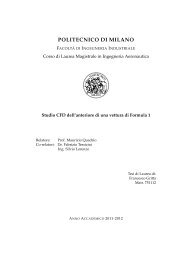
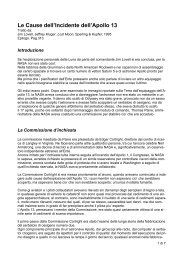
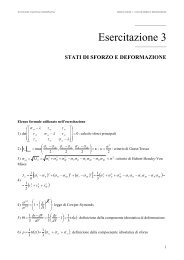
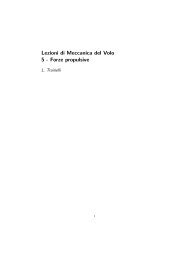

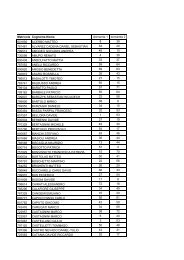
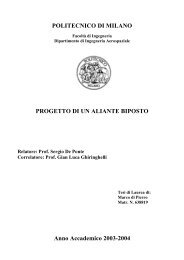

![[12.06.12] Coordinamento di Aeroporto 2012](https://img.yumpu.com/16337305/1/190x143/120612-coordinamento-di-aeroporto-2012.jpg?quality=85)
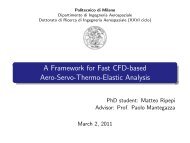
![[11.06.10] Lo strato limite turbolento](https://img.yumpu.com/16319523/1/184x260/110610-lo-strato-limite-turbolento.jpg?quality=85)
